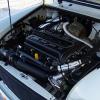
Piston Skirt Slits
#16

Posted 27 March 2008 - 03:16 PM
#17

Posted 27 March 2008 - 05:45 PM
Does the skirt of the piston see that much impact?
The explosion happens on the crown, what happens at the skirt?
You would think (but again bad things happen when one assumes) that something like this (picture below) will be weaker that the slit shown in the piston above because of the horizontal area as opposed the vertical?
(excuse my not so technical terms)

#18

Posted 27 March 2008 - 06:19 PM
just wondering... but why did you buy these pistons n not go for omega or AE's?
i bought an engine kit second hand becuase of the low milage MED stage 4 head and S-rods... these pistons were just part of the set
#19

Posted 27 March 2008 - 06:43 PM
Now take into consideration that force increases by the square of the velocity, and you can see that increasing the RPM the piston is being subjected to far greater acceleration and deceleration forces. A big slot that seperates the crown from the skirt will allow the crown of the piston to flex, higher rpms generate more foce on the pistons and the crown flexes more resulting in fatigue, if left un checked this will result in failure of the piston and probibly destruction of the whole engine and transmission.
This does not mean that you cannot use these pistons in a high performance engine, it just means the service life is very short. The other thing large slots in the pistons does is alow the piston to flex more, one reason was to dampen noise. This does not help support the piston in the bore at higher rpm and will increase ring blowby.
If you dont intend to take the engine above 6kprm, then the will be good for many tens of thousands of miles, if you take the engine above this, and by the spec of engine you listed, you will, expect to change the pistons in a couple of thousand miles, or else suffer catastrophic failure. No one really knows how long they will last, as it depends on the useage, so its better to be safe than sorry and replace them regularly.
As an example, the standard Rover A+ piston is considered the best production piston. These were used in Miglia engines up to 8500rpm by many a racer, but failures were experienced when mileage exceded around racing 500 miles. These pistons have a slot in the oil ring groove and by no means a big one. Granted racing miles usualy means full bore, but if you were to extrapolate, you would still find the life of the pistons very short considering they last well over 100k miles in a standard engine.
Pistons are not just pistons
The question has already been asked, and was one I was also wondering, why have you decided to use these pistons? what size bore are they?
#20

Posted 27 March 2008 - 06:47 PM
Since I'm no expert, I should ask...
Does the skirt of the piston see that much impact?
The explosion happens on the crown, what happens at the skirt?
You would think (but again bad things happen when one assumes) that something like this (picture below) will be weaker that the slit shown in the piston above because of the horizontal area as opposed the vertical?
(excuse my not so technical terms)
What you dont see in the pistons above is how big the slot could be behind the oil ring.
Any one show me a high performance piston with slots in the skirt or oil ring groove, and i will give you a tenner
#21

Posted 27 March 2008 - 07:52 PM
they're 73.52mm according to my vernia calipers - calibrated might i add
#22

Posted 27 March 2008 - 09:27 PM
#23

Posted 27 March 2008 - 09:46 PM
#24

Posted 27 March 2008 - 10:07 PM
that was taken from the widest point at the bottom of the skirt, i did notice the taper from the crown
1 user(s) are reading this topic
0 members, 1 guests, 0 anonymous users
















